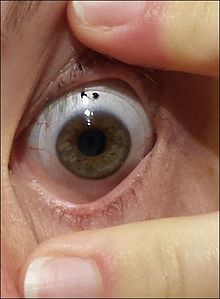Scleral lens
Scleral lenses are dimensionally stable, highly gas-permeable contact lenses . A scleral lens, unlike regular, dimensionally stable contact lenses, does not lie on the cornea, but on the dermis of the eye (the sclera ). Eugène Kalt invented the scleral lens for the visual therapy of keratoconus. Since around 2005 these have come to the fore again. New, highly gas-permeable materials enable a healthy supply of the eyes with large lenses. The relatively thick tear film between the lens and the corneal surface compensates for the irregularities of the eye and ensures a relatively good visual performance.
Medical use
Scleral lenses can be used to improve eyesight . They are suitable for people with pain and sensitivity to light with a growing number of diseases or injuries to the eye, such as severe dry eye syndrome , microphthalmia , keratoconus , keratectasia , Stevens-Johnson syndrome , Sjogren's syndrome , aniridia , neurotrophic keratopathy , Complications after LASIK surgery, severe aberrations of the eye, complications after corneal transplantation and pellucid marginal degeneration . Injuries to the eye such as surgical complications, distorted corneal implants, and chemical injuries and burns can also be treated through the use of scleral lenses. Scleral lenses can also be used on people who are too sensitive to soft or hard contact lenses but need a rigid lens for vision correction such as astigmatism .
With pronounced keratoconus, scleral lenses can often achieve better visual acuity than small corneal contact lenses. The crooked lens surfaces and the usually strong mobility of the small, hard lenses often produce strong optical aberrations and inconsistent vision . The low movement, the constant thickness of the tear film between the eye and the lens and the flatter radii of curvature of the sceral lens create an ideal optical system and clearer vision.
Newer usage
Today colored scleral lenses are often used for cosplay , as a party gag or at carnival .
advantages
Are stable and scratch-resistant with a longer service life than normal lenses, have little tendency to form deposits and require less maintenance. The wearing comfort of scleral lenses can be equated with that of soft lenses, as the lenses are much larger, move less on the eye and do not touch the sensitive cornea.
disadvantage
Since almost the whole eye is covered and not only parts of the cornea , as is the case with a smaller contact lens , there is a risk that the eye will be poorly supplied with nutrients and oxygen. This is particularly the case with "party lenses", as these are less permeable to gas and have not been adapted to the eye. There is a risk of dangerous eye diseases, in the worst case even loss of vision. Ophthalmologically prescribed and professionally fitted scleral lenses are no more dangerous than normal lenses. Specific complications are infections and conjunctival damage. Divers have not reported any serious problems with such lenses.
Individual evidence
- ^ Sjogren's Syndrome Foundation Releases Clinical Practice Guidelines for Ocular Management in Sjogren's Patients . Sjogren's Syndrome Foundation.
- ↑ Vanessa Caceres: Taking a second look at scleral lenses . In: ASCRS EyeWorld . June 2009. Retrieved May 18, 2014.
- ↑ Gregory Gemoules: scleral contact lenses - explained ' . LaserFit. Retrieved May 18, 2014.
- ↑ MK Walker, JP Bergmanson et al. a .: Complications and fitting challenges associated with scleral contact lenses: A review. In: Contact lens & anterior eye: the journal of the British Contact Lens Association. Volume 39, number 2, April 2016, pp. 88-96, doi : 10.1016 / j.clae.2015.08.003 , PMID 26341076 (review).
- ↑ Elving-Kokke K, Germonré P, Visser E: Scleral lens wear in scuba and deep-sea diving. Contact Lens Spectrum, October 1, 2017 (accessed February 9, 2018)


